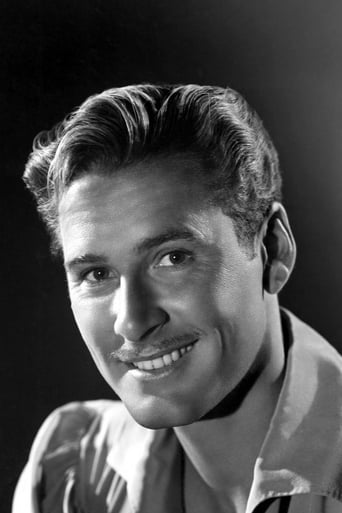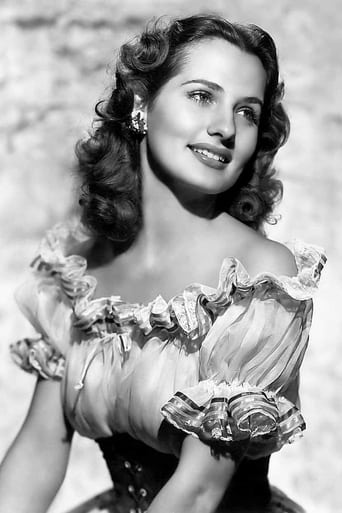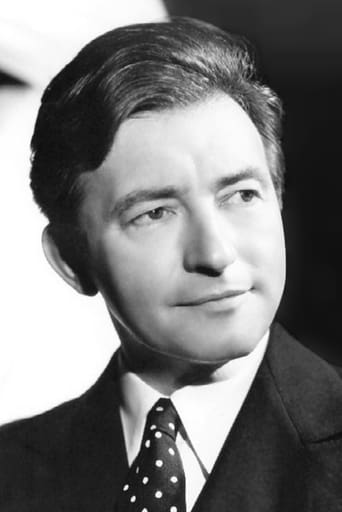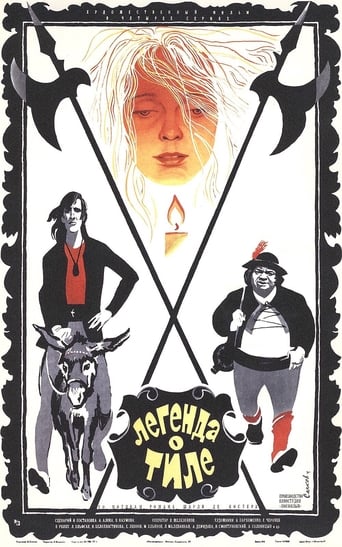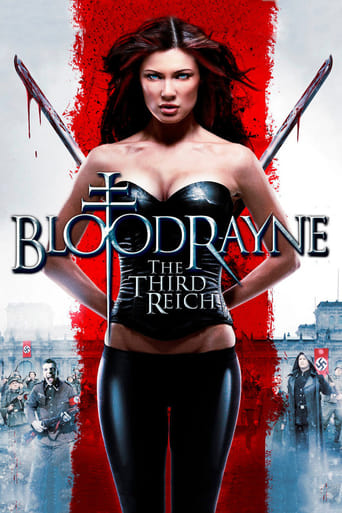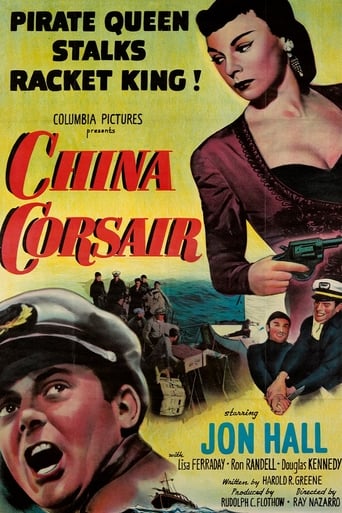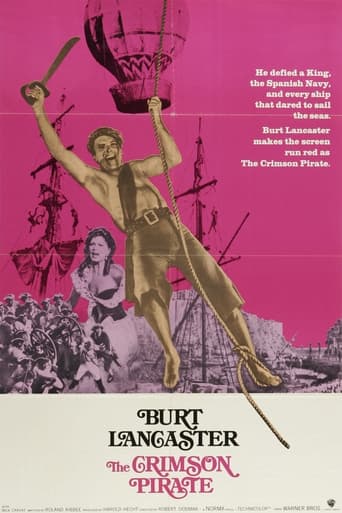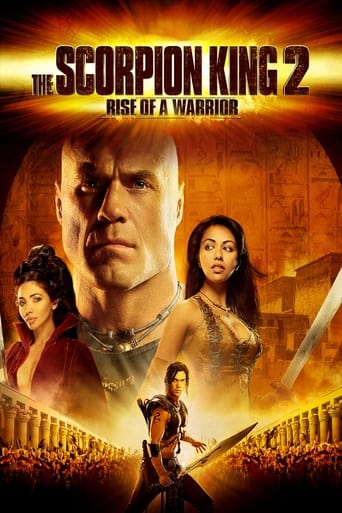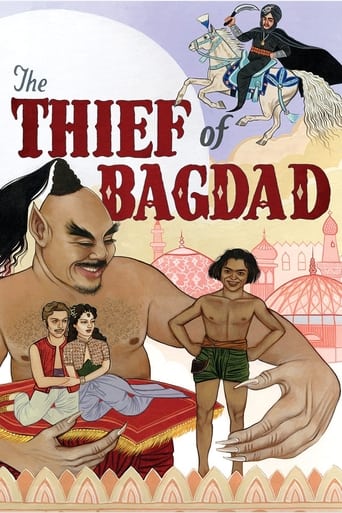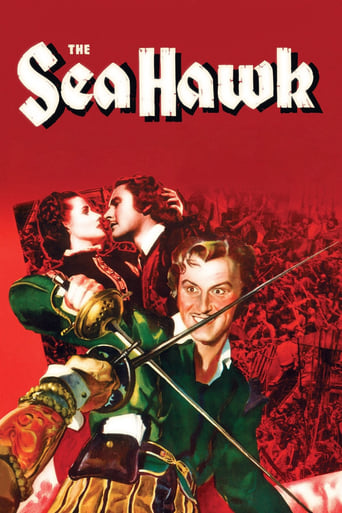
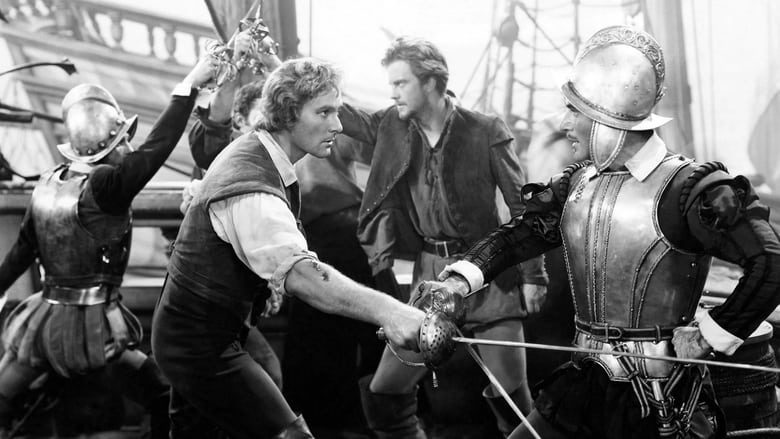
The Sea Hawk (1940)
Dashing pirate Geoffrey Thorpe plunders Spanish ships for Queen Elizabeth I and falls in love with Dona Maria, a beautiful Spanish royal he captures.
Watch Trailer
Cast
Similar titles
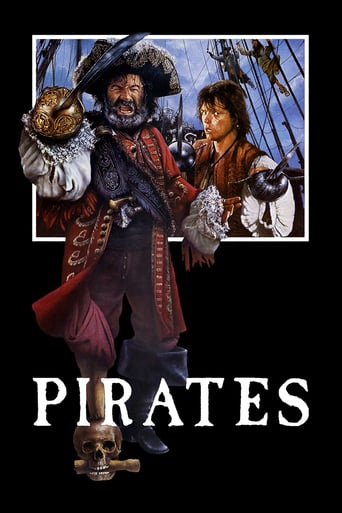

Reviews
Powerful
Better than most people think
Exactly the movie you think it is, but not the movie you want it to be.
The film never slows down or bores, plunging from one harrowing sequence to the next.
I have long been a fan of the pictures that Warner Brothers put out in the 1930s and '40s, as well as a longtime fan of Tasmanian-born actor Errol Flynn, of Hungarian director Michael Curtiz, and of the genre of film known as the swashbuckler, so it was perhaps inevitable that 1940's "The Sea Hawk" should wind up on my personal Top 10 list. But it is perhaps strange that I should rank this particular swashbuckler so very high, when so many others have topped it in various departments. Flynn's breakthrough film, the swashbuckler "Captain Blood" (1936), was there first, and features a short but very sweet beachside sword fight between Flynn and Basil Rathbone; "The Adventures of Robin Hood" (1938), also starring Flynn, is one of the most gorgeously filmed Technicolor movies ever made ("The Sea Hawk" was shot in B&W) and also features one of the greatest sword fights in cinema history, that between Flynn and Rathbone at the picture's conclusion; "The Mark of Zorro" (1940) also sports one of the finest sword fights of all time, that between star Tyrone Power and, still again, villainous Basil Rathbone; and "Scaramouche" (1952) gave us what is most likely THE very greatest (and lengthiest) sword fight in film history, a truly acrobatic and swinging affair between star Stewart Granger and villainous Mel Ferrer. (And by the way, I am using the term "sword fight" here generically, with full knowledge that many of these bouts were between two men fencing with rapiers or foils.) But for this viewer, "The Sea Hawk" remains the greatest swashbuckler of them all; a film in which all the elements come together to create one truly rousing and memorable film experience. After having been produced by the Warners studio at a cost of $1.7 million, the picture opened on July 1, 1940 and proved modestly successful at the box office, ultimately raking in $2.6 million. Based on Rafael Sabatini's 1915 novel "The Sea Hawk," the picture was actually a remake; the 1924 silent film, which I have also seen and enjoyed, supposedly hews a lot closer to the novel than does the Curtiz production, which uses as its model the exploits of the British sailor Sir Francis Drake. Personally, I have seen the 1940 film several dozen times and never seem to tire of it. I have seen it on both the small screen at home and on the large screen theatrically, and it never fails to leave this viewer with a happy grin on his face by the closing credits. Now almost 80 years old, it would seem to be a film for the ages."The Sea Hawk" takes place during the reign of Elizabeth I, a time during which the Spaniards were getting their famous armada together to wage war; in other words, just prior to the year 1588. As the film opens, the Spanish king, Philip II, sends his ambassador Don Alvarez (the always-wonderful character actor Claude Rains) to England, accompanied by his niece, Dona Maria (Brenda Marshall), to convince Elizabeth that Spain has no hostile intentions as regards any of its neighbors. While en route, the ambassador's ship is captured by the Albatross, under the command of privateer Geoffrey Thorpe (our Errol), and Alvarez and his niece are taken prisoners. Back in England, Elizabeth (truly regally portrayed here by Flora Robson, who was 38 at the time and here portraying a monarch who would have been, in 1588, 55 years old) publicly chastises Thorpe for his actions, but privately commends his deeds and valor on behalf of England. Thorpe is later given a rather hazardous assignment: to take his ship to the isthmus of Panama, in the New World, and capture a Spanish gold caravan that will soon be traveling there. And all would have gone well with this mission, had not traitorous Lord Wolfingham (the always hissable Henry Daniell) tipped the Spaniards off in advance. Thorpe and his men are ambushed in the swamps of Panama and many of them are killed; the few who remain are shipped back to Spain, stand trial under the Inquisition, and are sentenced to live out the rest of their lives as galley slaves aboard a Spanish galleon. Can Thorpe and his fellows ever escape from their rowers' shackles, make it back to England, and convince the queen of Spain's real intentions?"The Sea Hawk" was the 10th film that Curtiz and Flynn collaborated on together, and by now, the team was working like a well-calibrated machine. Besides "Captain Blood" and "The Adventures of Robin Hood," those previous films had been "The Charge of the Light Brigade"; the Westerns "Dodge City," "Santa Fe Trail" and "Virginia City"; the swashbuckler "The Private Lives of Elizabeth and Essex," in which Bette Davis essayed the role of Elizabeth (a very different interpretation of the role as compared to Robson's); and even lighthearted comedies such as "The Perfect Specimen" and "Four's a Crowd." Curtiz really makes his film move here, and nobody, for my money, has ever excelled Flynn in this type of role. The director and actor are abetted by the Warners studio working at peak efficiency, and aided by a raft of wonderful Warners character actors: Alan Hale, Donald Crisp, Una O'Connor, Gilbert Roland, Montagu Love, et al. And perhaps most especially by the great composer Erich Wolfgang Korngold, whose rousing and lusty score for this film, once heard, will never be forgotten. Korngold had previously contributed the scores for "Captain Blood," "Adventures of Robin Hood" and "Private Lives...," but his work here is truly spectacular. Finely shot by DOP Sol Polito, featuring sumptuous sets, and boasting a sparkling screenplay by Howard Koch and Seton I. Miller, "The Sea Hawk" is a class production all around. It is perhaps most famous today for the inspirational speech that Elizabeth makes toward the film's conclusion, in which she forcefully declaims the necessity of a country and her people to fight for their freedom; a speech that was seen as a Hollywood message to our British allies overseas during the early days of WW2. It is a film that really cannot be bettered, I feel...unless it would be to substitute Brenda Marshall with Olivia de Havilland, Flynn's frequent costar. But having a different leading lady play opposite the great Flynn for a change can hardly be seen as a bad thing, and Marshall surely does possess a unique charm of her own.On a personal note, there is one scene in "The Sea Hawk" that is an especial favorite of mine, and that I think back on frequently. It is the scene in which Thorpe and his men escape from their shackles and take over the Spanish galleon, a truly thrilling sequence indeed. By this time, the English slaves are in a pretty sorry state, dirty and worn out from their incessant, backbreaking toil. They are as abject a lot as can be imagined. But after they capture the ship, and put their Spanish tormentors belowdecks, they turn around and set sail for England, doing the same backbreaking work, but now joyful and singing lustily as can be, the great Korngold theme bellowing from their throats. The same exact work, but under different circumstances. That really strikes a chord with yours truly. As a proofreader and copy editor, I often sit at my office desk and read the most egregiously awful dreck all day long. And come evening, I often go home and...do what? Read! But now I am reading what I want to read, and what a difference it makes! Freedom is the difference, of course; the freedom to be doing what you want to be doing. And that message has never been shown more effectively than in that wonderful scene in "The Sea Hawk."It has just struck me that I have yet to mention the climactic sword fight that caps the action in this very fine film...that between Flynn and Daniell. While perhaps not as memorable as that of some of the others mentioned above, it is yet a highly satisfying affair, bringing to a close a film that should manage to charm and entertain audiences of all ages. If you have never had the pleasure of seeing this film, I would urge you to put it at the very top of your list. Personally, after not having seen it for a good number of years, I find that I am now hankering for another good solid dose of Geoffrey Thorpe & Co....
Great naval adventure, set at the time of the Spanish Armada. Entertaining, with a solid plot and great, and quite realistic, action scenes. Considering this was made in 1940, the recreations and special effects are amazing. No CGI, good old fashioned real ships.Errol Flynn was perfect for the lead role: dashing, swashbuckling, charming. Easily his best movie. Good support from Brenda Marshall and Flora Robson (as Queen Elizabeth I).A classic.
Brenda is not Olivia, and Henry quite definitely is not Philip St.John Basil Rathbone, MC. Sorry, folks, but with ersatz ingredients, the cake just doesn't taste quite right, although millions were spent in baking it. Flynn does his very best; he looks good, moves well, speaks well, flaunts his gear as if ladled into it, and he was an absolutely great swasher, but somehow I didn't feel his heart was truly into this buckler. The ship models were annoyingly unrealistic; Henry Daniell was such a pathetic pussy he had to have a blatantly obvious double in the fencing scenes, besides which Elizabeth's Walsingham should sue him for character assassination and outright defamation. Robson was a sight better than Bette Davis, but there have been several better Elizabeths since. Also, this film is too long, and it starts to drag about half way through, when they get to sepia-tinted Panama. There's too much talk, as well. And that monkey was robbed of its Oscar. Never mind, it's all good anti-German fun: there are definite parallels between the Nazis and the Spanish Inquisition. Korngold ratchets up the sound. Time Magazine reviewed the performance with its usual inaccuracy, calling Flynn "the Irish Cinemactor". I often wonder about these WW2 movies: do they show this in Argentina nowadays ? Do they show Henry V in France ?
This is yet another vintage film that I'm only just catching up with, some 70 years after its initial release and this probably has a lot to do with how indifferent I feel about it. Whilst I've always found Errol Flynn charming with great charisma I sensed a strain on both here. Brenda Marshall is wooden in the extreme and there is absolutely no chemistry between her and Flynn. Claude Rains, too, seems oddly ill-at-ease possibly because unlike his Captain Renault in Casablanca he is not permitted to display the impish side of his character and come on as more of a lovable rogue than black-as-night villain. Even the swordplay was lacklustre and it's too easy to say that Henry Daniell is a poor substitute for Basil Rathbone. I've given it five out of ten whereas had I seen it earlier I may have gone to seven or eight.
